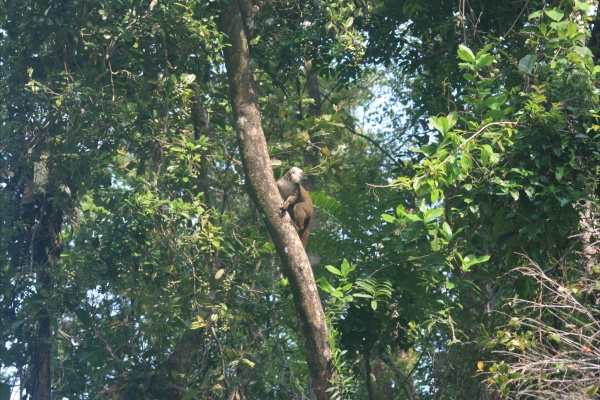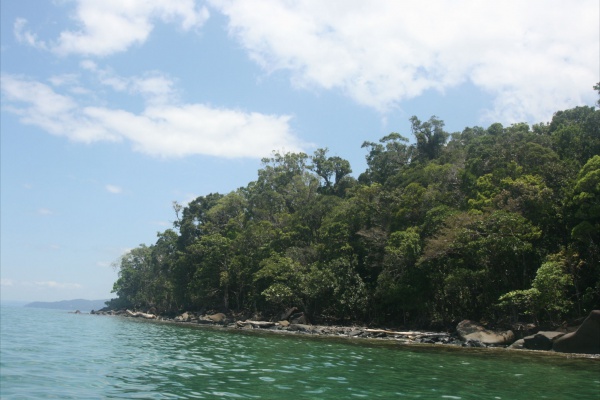Masoala National Park
The Masoala National Park is located on the Masoala peninsula in the north-east of Madagascar. The peninsula is enclosed by the Indian Ocean in the east and Antongil Bay in the west. On and around the Masoala peninsula are several protected areas. The Masoala National Park combined with the Nosy Mangabe Special Reserve within the bay is the largest nature protected area in Madagascar.
Masoala can be translated to the eye of the forest - maso meaning eye and ala meaning forest in Malagasy. According to history, the first inhabitants of Madagascar settled in the Masoala region. During the 15th and 16th century, slave traders stopped at Nosy Mangabe on their sails to Asia or Europe. Today, the Betsimisaraka remain the dominant ethnic group of the Antalaha and Maroantsetra region. The people of Maroantsetra call themselves Antimaroa.
The Masoala National Park was created on the 2nd March 1997 and the Nosy Mangabe Special Reserve on the 14th December 1965. Masoala National Park is one of six national parks on the east coast of Madagascar, all of which were declared a World Heritage in Danger by UNESCO under the combined name Rainforests of the Atsinanana in 2010.
The entire Masoala protected area with a total surface of 240,520ha is divided into four terrestrial sections and three marine zones:
- The main land plot covers 227,020ha of forest
- The detached land plot of Andranoanala covers 1,300ha
- The detached land plot of Andranomainty covers 1,600ha
- The detached land plot of Beankora covers 620ha
- The marine plot of Tampolo covers 3,600ha
- The marine plot of Masoala covers 3,300ha
- The marine plot of Tanjona covers 3,100ha
The additional Nosy Mangabe Special Reserve has an area of 520ha.
Masoala is the wettest region in Madagascar, with an average annual rainfall between 2,200mm and 7,000mm. The driest months span between September and December. The tropical humid and warm climate is typical of eastern Madagascar. In general, the temperature varies between 24°C in January and 21°C in August.
The Masoala peninsula is very uneven in its northern and western parts. Further south, the slopes are less steep and a coastal plain stretches between Tampolo and Cap Masoala. The east side descents to a coastal plain with a width of up to 15km. Along the coast rocks alternate with sandy bays and reefs are located not far from the shore.
The particularity of Masoala is its terrestrial ecosystem, which is characterised by rainforests ranging from 0m to 1,300m above sea level. Masoala is one of the rare regions of Madagascar where the edge of the forest literally meets the sea. A fragile forest corridor joins the forest of the Masoala peninsula with the Anjanaharibe-Sud Special Reserve and the Makira Plateau. The existence of the corridor is essential to prevent Masoala from becoming an isolated ecosystem in terms of wildlife.
The marine and coastal ecosystem is characterised by several forest and rock patches, sandy bays, coral reefs, seagrass beds and narrow strips of mangrove forest.
In terms of biodiversity, Masoala is one of the richest regions of Madagascar. 50% of Madagascar's plant species and more than 50% of Madagascar's mammals, birds, amphibians and reptiles can be found here.
The Masoala protected area is a very important water reserve for the region, as it supplies water for the rice fields and is a source of drinking water. The development of ecotourism benefits the local population, generating jobs such as guides, porters, craftsmen and merchants.
Contents
Conservation targets
Despite its strategic role, Masoala is threatened by human activities:
- Dense humid forest 0m - 800m: Land clearing, illegal logging of precious timber
- Eastern coastal forest: Highly threatened due to its proximity to villages
- Reef: Erosion and silting threaten the coast, seagrass beds and mangroves
Protected species are highly threatened by poaching within and outside the protected area:
- Varecia rubra - Red ruffed lemur (endemic to Masoala)
- Eretmochelys imbricata - Hawksbill sea turtle
- Chelonia mydas - Green sea turtle
- Lepidochelys olivacea - Olive ridley sea turtle
- Caretta caretta - Loggerhead sea turtle
- Dermochelys coriacea - Leatherback sea turtle
- Voanioala gerardii - forest coconut, very rare palm (endemic to Masoala)
- Nepenthes masoalensis - carnivorous plant (endemic to Masoala)
How to get there
There are two ways to reach the park, either via Maroantsetra or via Antalaha. The easiest and fastest mode of transport is by plane. Air Madagascar operates scheduled flights to Maroantsetra and Antalaha.
A car ride from Tamatave to Maroantsetra along the RN5 takes about two days (400km) mostly on a very bad road, which is often closed due to cyclones from December to March. Coming from Antalaha, there is a 45km stretch to Andranoanala (Cap Est). During the dry season the ride takes about four hours by 4x4 car, while in the rainy season some bridges may be impassable and rivers must be crossed by pirogue.
Alternatively and if coming by Tamatave, it is possible to reach Maroantsetra by sea. Depending on the season, cargo boats leave three to six times a week from Tamatave. The journey by sea takes between one and two days.
Ecosystems of Masoala National Park
Given its vastness, the Masoala National Park has several types of habitats in both terrestrial and marine ecosystems:
- Dense humid forest 0m - 400m, dense humid forest 400m - 800m, dense humid forest 800m - 1,200m, dense humid forest 1,200m - 1,300m
- Island forest (in addition to the Nosy Mangabe Special Reserve, there are ten other forested islands surrounding the Masoala peninsula)
- Eastern coastal forest
- Flooded eastern coastal forest
- Coral reef
- Mangrove
- Herbarium zone
These habitats can be grouped into three categories:
- Dense humid forest
- Eastern coastal forest
- Marine environment
Fauna
Birds
Until 2008, 102 species of birds have been identified in Masoala, of which over 60% are endemic to Madagascar. Different inventories led to the rediscovery of the Eutriorchis astur (Madagascar Serpent Eagle) in 1993. The Madagascar Serpent Eagle is considered the rarest bird of prey in the world and Masoala is currently the only place where this species has been observed on several occasions.
Masoala is also the home of the Tyto soumagnei (Madagascar red owl), which was first discovered in the forest of the Ambanizana region on Masoala peninsula. The Madagascar red owl is one of the rarest birds in Madagascar and one of the most endangered species of owls in the world.
Fourteen bird species are considered vulnerable and threatened in Masoala:
| Scientific name | English name | |
| Eutriorchis astur | Madagascar Serpent Eagle | Endemic to Madagascar. |
| Accipiter Henstii | Henst's goshawk | Endemic to Madagascar. |
| Coua serriana | Red-breasted coua | Endemic to Madagascar. |
| Atelornis pittoides | Pitta-like ground roller | Species belonging to a family endemic to Madagascar. |
| Phyllastrephus cinereiceps | Gray-crowned greenbul | Endemic to Madagascar. |
| Oriolia bernieri | Bernier's vanga | Endemic to Madagascar. |
| Pseudobias wardi | Ward's flycatcher | Endemic to Madagascar. |
| Tyto soumagnei | Madagascar red owl | Endemic to Madagascar. |
| Lophotibis cristata | Madagascan crested ibis | Endemic to Madagascar. |
| Mesitornis unicolor | Brown mesite | Rare species belonging to a family endemic to Madagascar. |
| Randia pseudozosterops | Rand's warbler | Endemic to Madagascar. |
| Euryceros prevostii | Helmet vanga | Endemic to Madagascar. |
| Brachypteracias leptosomus | Short-legged ground roller | Species belonging to a family endemic to Madagascar. |
| Brachypteracias squamiger | Scaly ground-roller | Species belonging to a family endemic to Madagascar. |
The best fauna most visible to tourists
| Scientific name | English name / Malagasy name | Description | Where to find | When to find |
| Varecia rubra | Red ruffed lemur. | Rust-coloured lemur. | In the lowland forest of Masoala. | All year round. |
| Euryceros prevostii | Helmet vanga / Siketribe | Bird with large blue beak. | In the lowland forest of Masoala. | All year round. |
| Daubentonia madagascariensis | Aye-aye | Nocturnal lemur, the strangest mammal of Madagascar. | Nosy Mangabe | All year round. |
| Uroplatus fimbriatus | Common flat-tailed gecko / Tahafisaka | Nocturnal gecko, lives in the trees. | Nosy Mangabe | All year round. |
Accommodation
Tampolodge
Fax: +261 020 5772149
Email: f-f@wanadoo.mg
Website: www.masoalamadagascar.com
Masoala Forest Lodge
Tel: +41 52624 1077 (Switzerland)
Email: mea@wanadoo.mg
Website: www.masoalaforestlodge.com
Arol Lodge
Tel: 033 12 902 77
Email: masoala@free.fr
Website: http://arollodge.free.fr/home.htm
Cap Est
Cap Est is the eastern most point of Madagascar and can reached by boat or by trekking from Antalaha or Maroantsetra. The closest town is Ambodirafia.
- La Résidence du Cap
- Hotel du Voyage

